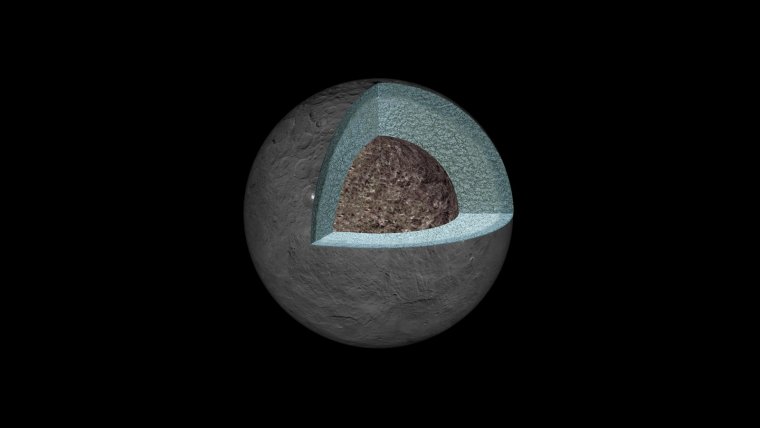| News / Science News |
What's Inside Ceres? New Findings from Gravity Data
NASA | AUGUST 13, 2016
The new data suggest that Ceres has a weak interior, and that water and other light materials partially separated from rock during a heating phase early in its history.

A diagram of how the inside of Ceres could be structured. ![]()
Ceres' gravity field is measured by monitoring radio signals sent to Dawn, and then received back on Earth, by NASA's Deep Space Network. This network is a collection of large antennas at three locations around the globe that communicate with interplanetary spacecraft.
Using these signals, scientists can measure the spacecraft's speed to a precision of 0.004 inches (0.1 millimeters) per second, and then calculate the details of the gravity field.
Ceres has a special property called "hydrostatic equilibrium," which was confirmed in this study. This means that Ceres' interior is weak enough that its shape is governed by how it rotates. Scientists reached this conclusion by comparing Ceres' gravity field to its shape. Ceres' hydrostatic equilibrium is one reason why astronomers classified the body as a dwarf planet in 2006.
The data indicate that Ceres is "differentiated," which means that it has compositionally distinct layers at different depths, with the densest layer at the core.
Scientists also have found that, as they suspected, Ceres is much less dense than Earth, the moon, giant asteroid Vesta (Dawn's previous target) and other rocky bodies in our solar system. Additionally, Ceres has long been suspected to contain low-density materials such as water ice, which the study shows separated from the rocky material and rose to the outer layer along with other light materials.
Scientists also found that high-elevation areas on Ceres displace mass in the interior. This is analogous to how a boat floats on water: the amount of displaced water depends on the mass of the boat.
Similarly, scientists conclude that Ceres' weak mantle can be pushed aside by the mass of mountains and other high topography in the outermost layer as though the high-elevation areas "float" on the material below. This phenomenon has been observed on other planets, including Earth, but this study is the first to confirm it at Ceres.
YOU MAY ALSO LIKE




